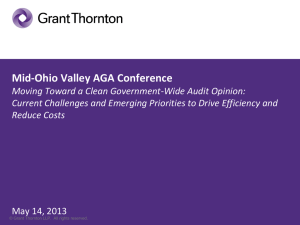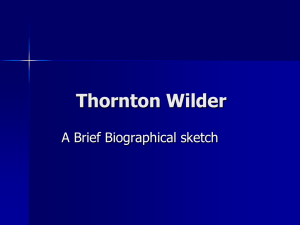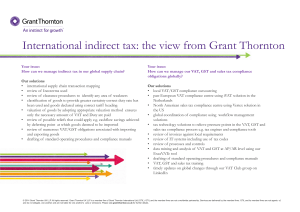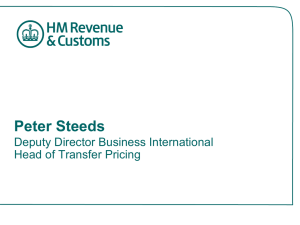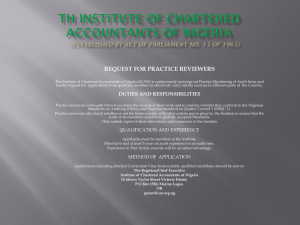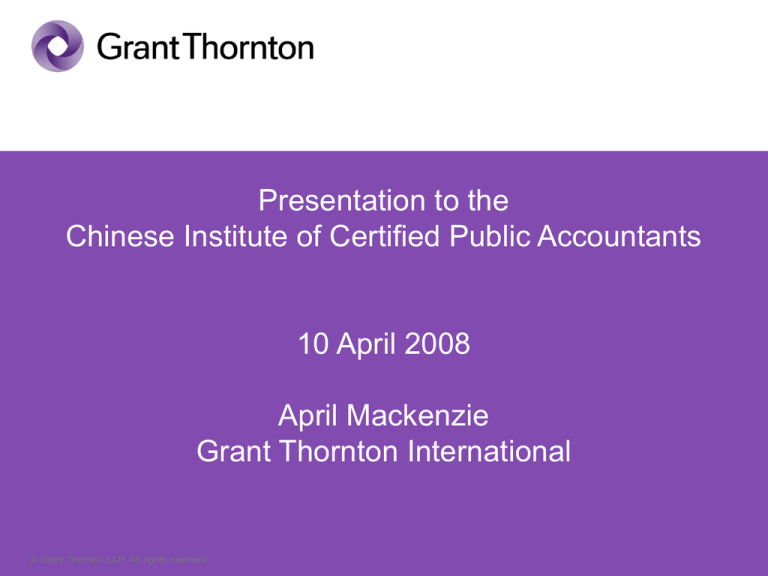
Presentation to the
Chinese Institute of Certified Public Accountants
10 April 2008
April Mackenzie
Grant Thornton International
© Grant Thornton LLP. All rights reserved.
Today's Agenda
• external quality control
– overview of two oversight entities
• Public Company Accounting Oversight Board
(PCAOB) – United States
• Financial Reporting Council (FRC) – United
Kingdom
• internal quality control: ISQC 1
• policy goals for the accounting profession
© Grant Thornton LLP. All rights reserved.
2
Topic 1: external quality controls
• Public Company Accounting Oversight Board
(PCAOB) – U.S.
• Financial Reporting Council (FRC) – U.K.
© Grant Thornton LLP. All rights reserved.
3
United States: two primary national regulators
© Grant Thornton LLP. All rights reserved.
4
Public Company Accounting Oversight Board
(PCAOB)
• established by the Sarbanes-Oxley Act of 2002 (SOX).
• overseen by the U.S. Securities and Exchange Commission
(SEC).
• anon-profit corporation – not a U.S. government agency or
establishment.
• board consists of 5 full-time members:
– Only 2 members may have been CPAs.
– All Board members must be independent.
• PCAOB may issue rules regarding registration, inspection,
standards, enforcement.
• funded by "accounting support fees" levied on public
companies, based upon size of such companies.
© Grant Thornton LLP. All rights reserved.
5
PCAOB – main functions
• registration: SOX and PCAOB rules require
registration of public accounting firms that perform
audit for public companies.
• inspection: PCAOB must inspect firms that audit
public companies.
• standard setting: issues standards relating to
auditing, quality control, ethics, independence.
• enforcement: conducts investigations and
disciplinary proceedings and imposes appropriate
sanctions on firms and individuals.
© Grant Thornton LLP. All rights reserved.
6
PCAOB – publicly-stated goals
• promote investor confidence in audited financial
statements of public companies through use of supervisory
method of firm oversight.
• inform, educate and obtain feedback from audit profession,
market participants and others about the PCAOB's
oversight activities and auditing best practices.
• strengthen the effectiveness and coordination of auditor
oversight efforts in the U.S. and abroad.
• operate the PCOAB in a manner that recognizes its public
mission.
© Grant Thornton LLP. All rights reserved.
7
PCAOB registration – requirements
• U.S. accounting firms must register: public accounting
firms that are not registered with the PCAOB cannot
prepare or issue audit reports, on participate in audits, of
U.S. public companies.
• non-U.S. accounting firms must also register: any nonU.S. accounting firm that prepares or furnishes an audit
report for any U.S. public company is subject to PCAOB's
rules to the same extent as a U.S. accounting firm.
• must register even if firm does not prepare, issue or
furnish the report: rule 2100 requires registration if the
firm "plays a substantial role in the preparation or furnishing
of an audit report with respect to any issuer."
© Grant Thornton LLP. All rights reserved.
8
PCAOB registration – facts
** Numbers based on 2006 annual report (2007 annual report has not yet been published)
• total number of registered firms at 2006 year end: 1,738.
Since increased to 1843 as of 27 March 2008.
• foreign firm registration: 752 foreign firms at 2006 year end
(or 43% of total firms).
• small firm registration: 537 firms (31%) reported 1-5 audit
clients, and 976 firms (56%) reported no audit clients.
• countries with most PCAOB registered firms: U.S. (986);
China (68); U.K. (64); Canada (54); Australia (36) and India
(36).
© Grant Thornton LLP. All rights reserved.
9
PCAOB inspections – requirements
• all registered firms subject to inspection: all registered public
accounting firms – including foreign firms – are subject to regular and
special inspections in order to assess the degree of compliance of each
firm with SOX, PCAOB rules, SEC rules, and professional standards.
• larger firms: inspections shall be annually for firms that issue audit
reports for more than 100 issuers per year.
• smaller firms: inspections shall be at least once in every three years
for firms that issue audit reports for between 1 and 100 issuers, or that
play a substantial role in the preparation or furnishing of an audit report
with respect to at least one issuer.
• inspection reports: PCAOB issues inspection reports.
– portions of the report that deal with criticisms of, or potential defects
in, the firm's quality control systems are not made public if the firm
satisfactorily addresses those matters within 1 year.
– part of report is made public.
© Grant Thornton LLP. All rights reserved.
10
PCAOB inspections – facts
** Numbers based on 2006 annual report (2007 annual report has not yet been published)
• inspected 172 registered firms in 2006.
• of these firms, 9 audited more than 100 public companies
(the 8 largest U.S. firms, and one Canadian firm).
• other firms inspected include: 149 U.S. firms, and 14 nonU.S. firms located in 7 different countries (all of which
audited less than 100 public companies).
• reviewed portions of over 360 audits by largest 9 firms, and
over 720 audits performed by 163 smaller firms.
• inspectors are experienced: team leaders of large firm
inspections had average of 25 years relevant experience,
and all other members had more than 14 years experience.
© Grant Thornton LLP. All rights reserved.
11
PCAOB inspections – reliance on foreign
auditor oversight entities
• rule 4012: The PCAOB may rely on foreign oversight
entities for inspection.
• PCAOB lists five critical principles of any auditor
oversight system:
– adequacy and integrity of the system;
– the independence of the system's operation from the
auditing profession;
– the nature of the system's source of funding;
– the transparency of the system; and
– the system's historical performance.
© Grant Thornton LLP. All rights reserved.
12
PCAOB inspections – reliance on foreign
auditor oversight entities (cont'd)
• duplicative inspections – by PCAOB and home country
oversight entity – can lead to duplicative and possibly
inconsistent regulation.
• consequently, PCAOB recently issued exposure draft
regarding "full reliance" on foreign auditor oversight bodies
(i.e., no inspection by PCAOB).
• listed 25 "essential criteria" (under the five key principles)
that the PCAOB would consider in determining whether it
could place full reliance on a foreign auditor oversight body.
• good first step, but more recognition of foreign auditor
oversight bodies is required.
© Grant Thornton LLP. All rights reserved.
13
PCAOB inspections – reliance on foreign
auditor oversight entities (cont'd)
• Grant Thornton International issued comment letter to PCAOB.
• main Grant Thornton issues included:
– definition of "full reliance" did not really describe full reliance.
– listing of "essential criteria" would create a check-the-box
approach that would improperly use the U.S. system as a
benchmark.
• other jurisdictions can make different choices that are no
less effective.
• other jurisdictions have different capital markets that may
require different structures for auditor oversight entities.
– standard is not risk based, and does not discuss how the
PCAOB would prioritize among jurisdictions.
© Grant Thornton LLP. All rights reserved.
14
PCAOB inspections – reliance on foreign
auditor oversight entities (cont'd)
• other Grant Thornton comments to PCAOB include:
– PCAOB should not require full-time staff; rather, should merely
require access to sufficiently-qualified inspectors.
– knowledge of U.S. GAAP/GAAS is unnecessary if foreign
registrants use IFRS audited under ISAs.
– management of oversight entity should include a majority (as
opposed to entirely) of non-practicing auditors.
– PCAOB's desire to access inspection and other reports of foreign
oversight entities may not be permitted by certain jurisdictions.
– PCAOB should focus on whether the foreign oversight entity has the
ability to investigate.
– PCAOB should be careful about requiring foreign oversight entities
to impose "appropriate" sanctions for violations; different countries
may have different philosophies about sanctions and it is not for the
PCAOB to determine what sanctions are appropriate.
© Grant Thornton LLP. All rights reserved.
15
United Kingdom: two regulators
© Grant Thornton LLP. All rights reserved.
16
FRC: organization and primary responsibilities
Financial
Reporting Council
UK standard setters
APB
ASB
© Grant Thornton LLP. All rights reserved.
Financial
Reporting
Review Panel
Professional
Oversight Body
Accountancy
and Actuarial
Discipline Board
17
Background to the UK's Professional Oversight
Board (POB)
• formed in 2003 as an independent regulatory body
of the auditing profession; previously the audit
profession had been self-regulating.
• since 2006, the POB has responsibility for
oversight of both the accountancy and actuarial
professions.
• inspections of audit firms are carried out by the
Audit Inspection Unit (AIU), as a subsidiary body of
the POB.
• the board of the POB has 12 members.
© Grant Thornton LLP. All rights reserved.
18
The Audit Inspection Unit (AIU)
• director, a technical and quality control manager,
and approximately 16 full time inspectors.
• proposed 2008/9 budget £2.7m (2007/8 £2.2m).
• AIU will agree amendments with audit firms to
procedures where appropriate, and make
recommendations for appropriate regulatory
action.
© Grant Thornton LLP. All rights reserved.
19
Outline of the AIU's inspection methodology
• audit quality;
• reviews of firm-wide procedures, including culture
of the firm;
• risk based assessment of individual audits for
review;
• assignment reviews;
• assessment of communication with audit
committees.
© Grant Thornton LLP. All rights reserved.
20
AIU and reporting
• reports to the firm on individual assignments;
• formal private report, summarising results of
assignment reviews and firm-wide procedures, to
the audit registration committee;
• the firm is given the opportunity to comment on
draft reports;
• public reports have previously been issued on the
profession as a whole, on a no-names basis;
• public reports on the firm, and assignment reports
to be shared with the audit committee, from 2008.
© Grant Thornton LLP. All rights reserved.
21
Topic 2: internal quality control – International
Standard on Quality Control (ISQC) 1
• promulgated by the IAASB.
• ISQC 1 establishes standards and provides guidance
regarding a firm's responsibilities for its system of quality
control for audits and reviews of historical financial
information, and for other assurance and related services
engagements.
• such system should be designed to provide a firm with
reasonable assurance that the firm and its personnel
comply with professional standards and regulatory and
legal requirements, and that reports issued by the firm or
engagement partners are appropriate in the
circumstances.
© Grant Thornton LLP. All rights reserved.
22
ISQC 1
• applies to all firms.
• nature of the policies and procedures developed
by individual firms to comply with ISQC 1 will
depend on various factors such as the size and
operating characteristics of the firm, and whether
it is part of a network.
• effective date: 15 June 2006.
© Grant Thornton LLP. All rights reserved.
23
ISQC 1: quality control policies and procedures
• quality control policies and procedures should be
documented and communicated to the firm’s personnel.
– this includes the message that each individual has a
personal responsibility for quality and is expected to
comply with these policies and procedures.
• feedback on firm’s quality control system from its personnel
is important,
– therefore, personnel are encouraged to communicate
their views or concerns on quality control matters.
© Grant Thornton LLP. All rights reserved.
24
ISQC 1: elements of a system of quality control –
leadership
• firm's system of quality control should include policies and
procedures addressing each of the following six elements:
– leadership responsibilities for quality within the firm.
• CEO or managing board must assume ultimate
responsibility for quality control.
• firm leadership must recognize that firm's business
strategy is subject to overriding requirement for firm
to achieve quality.
• person assigned responsibility for quality control by
the CEO must have sufficient expertise, ability and
authority.
© Grant Thornton LLP. All rights reserved.
25
ISQC 1: elements of a system of quality control –
ethics
– ethical requirements, including independence (as set forth in the
IFAC Code of Ethics).
• code establishes the following fundamental principles of ethics:
– integrity;
– objectivity;
– professional competence and due care;
– confidentiality; and
– professional behavior.
• firm's policies and procedures should enable firm to:
– communicate independence requirements to its personnel;
– identify and evaluate threats to independence.
© Grant Thornton LLP. All rights reserved.
26
ISQC 1: elements of a system of quality control –
client relationship and human resources
– acceptance and continuance of client relationships/specific
engagements, and policies must ensure that:
• firm consider client's integrity;
• firm is competent to perform the engagement; and
• firm can comply with ethical restrictions.
– human resources, including policies designed to provide firm with
reasonable assurance that it has sufficient personnel with proper
capabilities to perform engagements.
• policies and procedures should address: recruitment;
performance evaluation; capabilities; competence; career
development; promotion; compensation; and estimation of
personnel needs.
© Grant Thornton LLP. All rights reserved.
27
ISQC 1: elements of a system of quality control –
engagement performance
– engagement performance, specifically procedures
designed to provide firm with assurance that
engagements are performed in accordance with
professionals standards and laws, including policies and
procedures that:
• ensure that appropriate consultation occurs on
difficult matters;
• deal with and resolve differences of opinion on the
engagement team; and
• require an engagement quality control review, which
provides an objective evaluation of significant
judgments made by the engagement team.
© Grant Thornton LLP. All rights reserved.
28
ISQC 1: elements of a system of quality control -monitoring
– monitoring
• the firm should establish policies and procedures
designed to provide it with reasonable assurance that
the policies and procedures relating to the system of
quality control are relevant, adequate, operating
effectively and complied with in practice.
• such policies and procedures should include an
ongoing consideration and evaluation of the firm’s
system of quality control, including a periodic
inspection of a selection of completed engagements.
© Grant Thornton LLP. All rights reserved.
29
Monitoring – practical tip
• should take place as early as possible after the
busy season to enable timely:
– communication of the issues to engagement
teams, training leaders, firm's management
board;
– recommendations;
– corrective actions;
– disciplinary sanctions; and
– training.
© Grant Thornton LLP. All rights reserved.
30
Topic 3: Public policy – goals for the accounting
profession
• two important policy goals for the accounting
profession:
– global adoption of international standards.
• accounting;
• auditing;
• ethics/independence.
– regulatory convergence.
© Grant Thornton LLP. All rights reserved.
31
Policy goals for the accounting profession (cont'd)
• reason for these goals: to improve the reliability
and relevance of financial reporting and auditing.
– improve capital market efficiencies.
– enhance the quality of audits in various regions.
– reduce audit costs.
© Grant Thornton LLP. All rights reserved.
32
Goal #1: Global adoption of international standards
• global sets of standards that countries should
adopt:
– International Financial Reporting Standards
(IFRS)
– International Standards of Auditing (ISAs)
© Grant Thornton LLP. All rights reserved.
33
International Financial Reporting Standards (IFRS)
• most countries are moving toward a single set of financial
reporting standards: IFRS, which are promulgated by the
IASB.
• U.S. is moving in that direction.
– specifically, the U.S. SEC just agreed to eliminate the
reconciliation requirement to U.S. GAAP for foreign
private issuers reporting in IFRS.
– further, the SEC issued a concept release that explores
allowing U.S. issuers to report under IFRS.
• important to reduce/eliminate country variation on IFRS –
goal is one financial reporting standard, not many
standards.
© Grant Thornton LLP. All rights reserved.
34
International Standards on Auditing (ISAs)
• ISAs are published by the International Auditing
and Assurance Standards Board (IAASB).
• like financial reporting standards, important to
move to one set of auditing standards.
• reduce costs, reduce complexity, increase
efficiencies – all of which benefit the capital
markets.
© Grant Thornton LLP. All rights reserved.
35
Forum of Firms requirements
• maintain appropriate quality control standards in
accordance with ISQC 1, in addition to relevant national
quality control standards; and conduct, to the extent not
prohibited by national regulation, regular globally
coordinated internal quality assurance reviews.
• have policies and methodologies for the conduct of audits
that are based, to the extent practicable, on ISAs issued by
the IAASB.
• have policies and methodologies which conform to the
IFAC Code of Ethics for Professional Accountants and
national codes of ethics.
© Grant Thornton LLP. All rights reserved.
36
Goal #2: Regulatory convergence
• this is closely related to adoption of global standards.
• convergence of regulatory regimes is necessary because
adoption of global standards will be of limited use if
standards are applied differently in different countries.
• conflicting regulatory regimes impede the auditing firms'
ability to deliver quality services to clients on a global basis.
• conversely, alignment of regulatory regimes could eliminate
or minimize the barriers that work against the firms' goal of
achieving consistently high levels of audit quality.
© Grant Thornton LLP. All rights reserved.
37
Examples: adoption of international standards and
regulatory convergence
• examples:
– International Federation of Accountants (IFAC)
Code of Ethics.
– U.S. PCAOB proposal regarding full reliance on
non-U.S. oversight entities (discussed
previously).
– U.S. SEC mutual recognition initiative.
– EC efforts on mutual recognition.
– CESR efforts on GAAP equivalence.
© Grant Thornton LLP. All rights reserved.
38
IFAC Code of Ethics
• IFAC is the worldwide organization for the accountancy profession.
There are a number of standard-setting boards that operate under the
auspices of IFAC.
• standard setting boards of IFAC are subject to independent oversight
and transparent due process
• one of these boards, the International Ethics Standards Board for
Accountants (IESBA), has published a comprehensive code of ethics
designed to govern the behavior of auditors.
• code addresses issues such as auditor independence, permissible nonaudit services, conflicts of interest.
• important to capital markets: dissimilar rules – particularly with respect
to independence – can disqualify auditors even if an independence
violation is de minimis and occurs at a small subsidiary.
© Grant Thornton LLP. All rights reserved.
39
SEC initiatives on mutual recognition
• in March, the U.S. SEC announced a series of actions it intends to take
to further the implementation of the concept of mutual recognition for
high-quality regulatory regimes in other countries. In particular, the
SEC contemplates taking the following actions:
– exploring agreements with foreign regulators, based upon a
comparability assessment by the SEC and by the foreign authority
of one another's regulatory regimes.
– considering adoption of a formal process for engaging other national
regulators on the subject of mutual recognition.
– developing a framework for mutual recognition discussions with
jurisdictions comprising multiple securities regulators tied together
by a common legal framework, including the European Union
(whose national securities regulators are subject to supranational
legislation and directives).
© Grant Thornton LLP. All rights reserved.
40
European Commission Efforts on Mutual Recognition
• EC paper: “Draft Commission Decision concerning a transitional period
for audit activities of certain third country auditors and audit entities.”
• Draft transitional provisions allow third country auditors to continue their
audits until at least 2012, provided that the auditor provides the
following information to the “competent authority” in the Member State
of that market:
– name and address of auditor and legal structure;
– a description of the audit network;
– the auditing standards and independence requirement applied to the
audit;
– a description of the internal quality control system of the auditor; and
– the date when the last quality assurance review of the auditor was
carried out and the outcome thereof.
© Grant Thornton LLP. All rights reserved.
41
CESR advice on GAAP equivalence
•
•
on 31 March, the Committee of European Securities Regulators (CESR)
published its advice to the European Commission on the equivalence of
Chinese, Japanese and US GAAPs.
CESR’s recommendations in the technical advice are the following:
– that the EC find US GAAP equivalent to IFRS for use on EU markets.
– that the EC consider Japanese GAAP equivalent, unless there is no
adequate evidence of the Accounting Standards Board of Japan
(ASBJ) achieving to timetable the objectives set out in the Tokyo
Agreement.
– that the EC postpone a final decision on Chinese GAAP until there is
more information on the application of the new Chinese accounting
standards by Chinese issuers.
• CESR noted that the first complete reporting period under the new
Chinese standards will only be for 2007 accounting periods.
• Thus, as yet no evidence available concerning the concrete
implementation of the standards by companies and auditors.
• CESR believes that evidence of adequate implementation is
important.
© Grant Thornton LLP. All rights reserved.
42
Presentation to the
Chinese Institute of Certified Public Accountants
10 April 2008
April Mackenzie
Grant Thornton International
© Grant Thornton LLP. All rights reserved.

